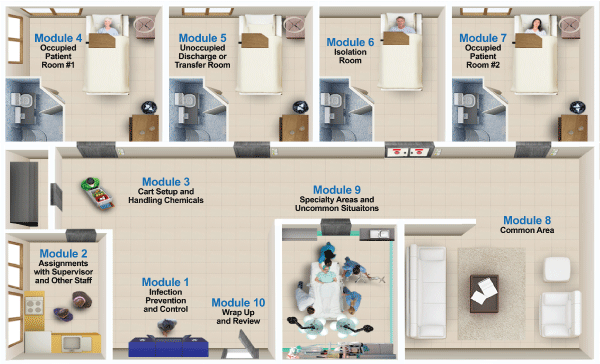
Certified Health Care Environmental Services Technician (CHEST) Curriculum
CHEST training workshops are comprised of 24 hours of required classroom instruction. The content covered during the workshops consists of seven domains: Cleaning and Disinfection, Waste Handling, Floor Care, Linen Handling, Infection Prevention, Safety, and Communication
CHEST Curriculum
Each domain is covered in a series of 10 modules. Each module requires a predetermined amount of instructional hours and has its own set of distinct learning objectives.
CHEST Modules

Module 1: Infection Prevention and Control (4.5 hours)
- Follow Standard Precautions to prevent patient and technician exposure to blood and other potentially infectious material (OPIM).
- Follow Standard Precautions for proper hand hygiene techniques.
- Follow Standard Precautions for appropriate use of Personal Protective Equipment (PPE).
- Follow Standard Precautions for proper respiratory etiquette/cough hygiene.
- Report Blood and Body Fluid exposures.
- Follow CDC Transmission Precautions recommendations for, entering and exiting and cleaning/disinfecting isolation rooms.
- Demonstrate required procedures for cleaning and disposing of blood or body spills in accordance with facility policy.
Module 2: Assignments with Supervisor and Other Staff (1.5 hours)
- Offer good customer service to patients and staff
- Recognize how to stay safe as an environmental services technician
- Identify how to keep patients safe
- Summarize key principles of infection prevention and control
- Recognize technician's critical role in infection prevention and control as a part of the patient care team
- Discuss the particular challenges of working in health care.
Module 3: Cart Setup and Handling Chemicals (1.5 hours)
- Explain how to prepare and handle chemicals needed for cleaning and disinfecting.
- List the differences between cleaning and disinfecting solutions, common examples of each, and how each is used.
- Determine the right cleaning solutions, tools, and techniques for different patient settings and surfaces.
- Recognize how to stay safe as an environmental services technician.
- Recognize technician's critical role in infection prevention and control as a part of the patient care team.
Module 4: Occupied Patient Room: Part 1
- List the differences between cleaning and disinfecting solutions, common examples of each, and how each is used.
- Determine the right cleaning solutions, tools, and techniques for different patient settings and surfaces.
- Explain how to clean a standard bed.
- Determine the right cleaning solutions, tools, and techniques for the bathroom.
- Identify how to properly handle and remove waste from a patient room.
- Select the right floor cleaning solution and tools based on the situation — mopping or vacuuming.
- Properly don and doff personal protective equipment (PPE).
- Explain how to handle clean and dirty linen.
- Recognize key principles of infection prevention and control.
- Recognize a health care environmental services technician’s critical role in infection prevention and control as a part of the patient care team.
- Recognize how to keep patients safe.
Module 5: Unoccupied Discharge or Transfer Room (1.5 hours)
- Perform discharge cleaning.
- Determine the right cleaning solutions, tools, and techniques for different patient settings and surfaces.
- Explain how to clean a standard bed.
- Explain how to handle clean and dirty linen.
- Make the bed according to facility standards.
- Recognize technician’s critical role in infection prevention and control as a part of the patient care team.
- Properly don and doff personal protective equipment.
- Summarize how to stay safe as an environmental services technician.
- Discuss how to keep patients safe.
- Offer good customer service to patients and staff.
- Demonstrate ethical behavior at all times and report unethical behavior.
Module 6: Isolation Room (2 hours)
- List the differences between cleaning and disinfecting solutions, common examples of each, and how each is used.
- Determine the right cleaning solutions, tools, and techniques for different patient settings and surfaces.
- Recognize different types of waste and how to handle each.
- Apply key principles of infection prevention and control.
- Identify types of precautions and modes of transmission.
- Summarize technician’s critical role in infection prevention and control as a part of the patient care team.
- Properly don and doff personal protective equipment.
- Demonstrate how to stay safe as an environmental services technician.
- Recognize how to keep patients safe.
- Recognize the basics of equipment safety.
Module 7: Occupied Patient Room: Part II (1.75 hours)
- Determine the right cleaning solutions, tools, and techniques for different patient settings and surfaces.
- Determine the right cleaning solutions, tools, and techniques for the bathroom.
- Offer good customer service to patients and staff.
- Recognize the particular challenges of working in health care.
- Respond to surveyor questions.
Module 8: Common Area (2 hours)
- Recognize the particular challenges of working in health care.
- Recognize how to respond to surveyor questions.
- Offer good customer service to patients and staff.
- Determine the right cleaning solutions, tools, and techniques for different patient settings and surfaces.
- Select the right floor cleaning solution and tools based on the situation – mopping or vacuuming.
- Recognize and report when a hard surface or carpeted floor needs advanced floor care.
- Recognize how to stay safe as an environmental services technician.
- Recognize the basics of equipment safety.
Module 9: Specialty Areas and Uncommon Situations (2 hours)
- Recognize key principles of infection prevention and control.
- Recognize technician’s critical role in infection prevention and control as a part of the patient care team.
- Determine the right cleaning solutions, tools, and techniques for different patient settings and surfaces.
- Recognize how to stay safe as an environmental services technician.
- Recognize how to keep patients safe.
- Identify the basics of equipment safety.
- Recognize the particular challenges of working in health care.
Module 10: Wrap Up and Review (2 hours)
- This module reviews all previous objectives through a review game.

